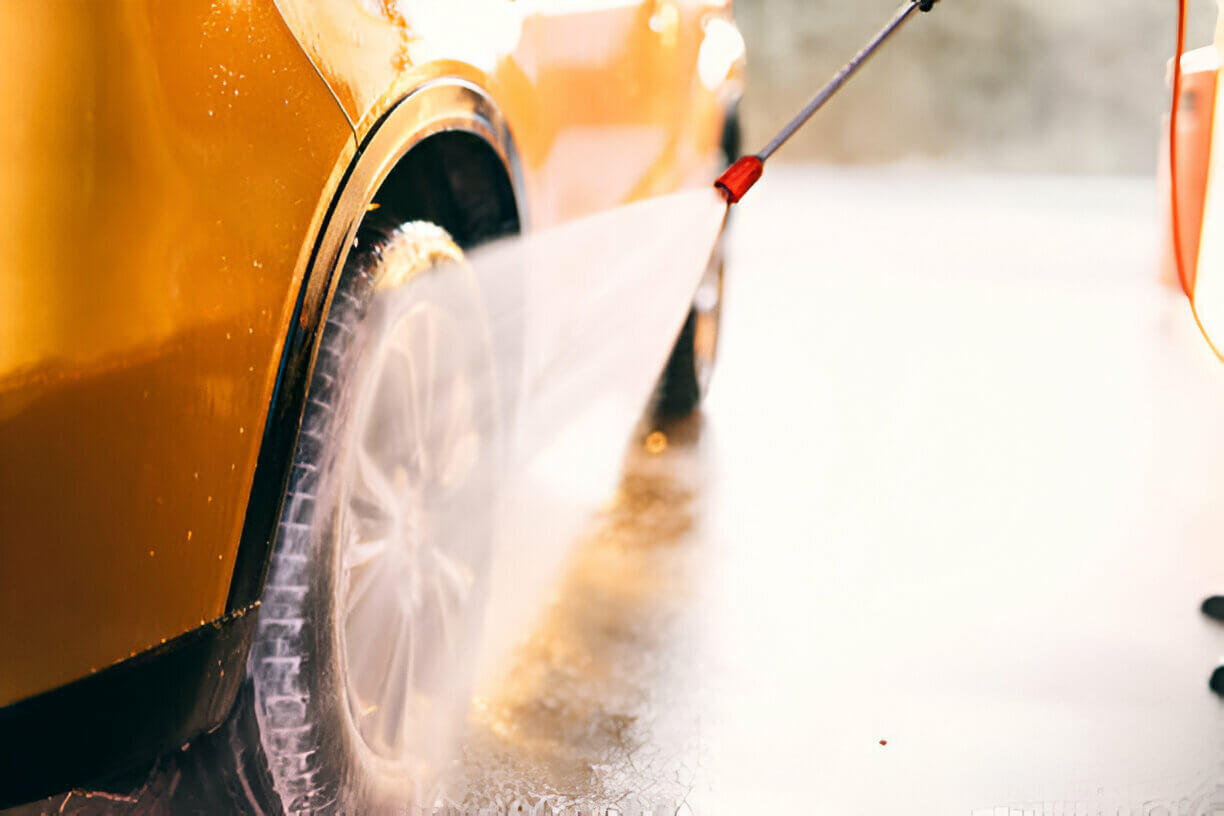Cleaning your car with a pressure washer can make the process faster and more effective compared to traditional methods. However, it’s important to use the right techniques and equipment to avoid damaging your vehicle. This guide provides detailed tips and steps to help you clean your car safely and efficiently using a pressure washer.

Why Use a Pressure Washer for Car Cleaning?
Using a pressure washer offers several benefits:
- Efficient Cleaning: The high-pressure water stream can quickly remove dirt, grime, and other contaminants.
- Saves Time: It reduces the overall time spent on washing your car compared to using a garden hose and sponge.
- Effective Pre-Rinsing: It breaks up tough soils like mud, bird droppings, and road grime, making the washing process easier.
Pressure washing not only speeds up the cleaning process but also ensures a more thorough clean, reaching areas that might be difficult to tackle with manual washing. By effectively removing contaminants, you can maintain the paint’s integrity and avoid long-term damage.
Choosing the Right Pressure Washing Equipment
Pressure Washer Types
There are two main types of pressure washers:
- Gas-Powered: These are powerful and suitable for heavy-duty tasks. They are ideal for large vehicles and heavily soiled surfaces.
- Electric: These are quieter, lighter, and easier to maintain. They are perfect for regular car cleaning tasks and are generally sufficient for most car owners.
When choosing between gas-powered and electric models, consider the frequency of use and the extent of cleaning required. For occasional use and standard cleaning, an electric pressure washer is often more than adequate.
Pressure Settings
For car washing, the recommended pressure is between 1200 and 1900 PSI. This range is strong enough to clean effectively without damaging the paint. Always start at the lower end of the range and increase as needed. Ensure the water flow rate (GPM) is also appropriate, ideally between 1.4 and 1.6 GPM.
Using the correct pressure settings helps avoid damage to the car’s exterior, including scratches and dents. Testing the pressure on a small, inconspicuous area before starting the full wash can help determine the best setting.
Nozzles
Pressure washers come with various nozzle tips that determine the spray pattern:
- 40-Degree Nozzle: Best for rinsing and general cleaning. It covers a wider area with less pressure, making it safe for car surfaces.
- 25-Degree Nozzle: Useful for cleaning wheels and undercarriages. It offers a narrower, more powerful spray for tougher dirt.
Each nozzle type has a specific use case, and choosing the right one for the job is essential for effective and safe cleaning. Avoid using a zero-degree nozzle as it can concentrate the water too intensely, causing damage to the paint.
Safety Precautions and Best Practices
Wear Protective Gear
Safety should always come first. Wear goggles to protect your eyes from flying debris and gloves to shield your hands. Ensure you’re wearing sturdy footwear to avoid injuries from the high-pressure water stream.
Pressure washers can cause serious injuries if not used correctly, so always ensure you’re well-protected before starting any cleaning project. Proper attire can prevent accidents and injuries during the washing process.
Proper Technique
- Maintain Distance: Keep the nozzle about 6-12 inches from the car’s surface to avoid damaging the paint.
- Sweeping Motion: Move the wand in a sweeping motion rather than focusing on one spot to prevent damage and ensure an even clean.
Proper technique is key to achieving professional results without harming the surfaces you’re cleaning. Keeping a consistent distance and using smooth, sweeping motions helps distribute the pressure evenly across the car’s surface.
Step-by-Step Guide for DIY Pressure Washing
Preparation
- Park in an Open Space: Choose a location like a driveway or a large open area to avoid hitting other objects.
- Close All Windows: Ensure all windows, doors, and the trunk are closed to prevent water from entering the car.
- Clear the Area: Remove any obstacles around the car and cover delicate areas like electrical outlets.
Preparation is crucial for a smooth and efficient cleaning process. Ensuring the area is clear and the car is properly sealed helps prevent damage and makes the washing process easier.
Equipment Setup
- Connect the Washer: Attach your pressure washer to a water source and connect it to power (for electric models).
- Attach Nozzle: Start with a 40-degree nozzle for general rinsing.
- Test the Pressure: Spray water on the ground to check the pressure before starting on the car.
Proper setup ensures that your equipment functions correctly and safely. Testing the pressure beforehand helps identify any issues and ensures the settings are appropriate for the task.
Cleaning Process
- Pre-Wash Rinse: Begin by rinsing the car to remove loose dirt. Start from the top and work your way down.
- Apply Detergent: Fill the detergent tank with car wash soap diluted as per the manufacturer’s instructions. Use the soap nozzle or apply manually with a cloth if your washer lacks a detergent tank.
- Let it Sit: Allow the detergent to sit for about five minutes, ensuring it doesn’t dry, especially in direct sunlight.
- Brush Stubborn Areas: Use a soft brush to scrub areas with tough grime, such as the wheels and lower panels.
Following these steps helps ensure that the detergent works effectively and that all areas of the car are addressed. Allowing the detergent to sit helps break down dirt and grime, making it easier to rinse off.
Rinsing and Post-Cleaning
- Rinse Off Detergent: Switch to the 40-degree nozzle and rinse the car thoroughly, starting from the top and moving down.
- Dry the Car: Use a soft towel or chamois to dry the car, preventing water spots and streaks.
Post-cleaning steps are essential for maintaining the cleanliness and condition of the surfaces. Proper rinsing and drying help avoid water spots and streaks, ensuring a polished finish.
Practical Tips and Best Practices
Start Slow
If you’re new to pressure washing, start with short sessions to get comfortable with the equipment. Gradually increase the duration as you become more confident.
Starting slow helps prevent mistakes and allows you to learn the proper handling of the pressure washer. Taking your time ensures a thorough clean without rushing the process.
Use Appropriate Chemicals
Always use detergents designed for pressure washers. Follow the manufacturer’s dilution instructions to avoid damaging the car’s finish.
Using the right cleaning agents can enhance the effectiveness of the pressure washing and ensure that surfaces are not damaged by harsh chemicals. Proper dilution is crucial for safe and effective cleaning.
Maintain Your Equipment
Regularly clean and inspect your pressure washer. Proper maintenance ensures it remains in good working condition and prolongs its lifespan.
Well-maintained equipment performs better and lasts longer, providing consistent cleaning results. Regular maintenance helps prevent breakdowns and ensures the pressure washer is ready for use when needed.
Conclusion
Pressure washing can transform your car cleaning routine, making it quicker and more effective. By following these tips and best practices, you can ensure a thorough and safe clean without damaging your vehicle. Whether you’re a beginner or experienced in car maintenance, these guidelines will help you achieve professional results.




